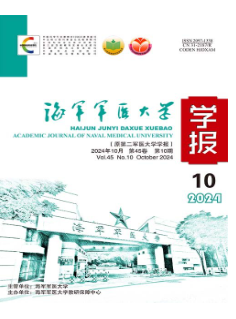Effect of anatomic liver resection on prognosis of patients with hepatocellular carcinoma
Q4 Medicine
引用次数: 1
Abstract
Objective To explore the effect of anatomic liver resection(AR) and non-anatomic liver resection(NAR) on the prognosis of patients with hepatocellular carcinoma(HCC).Methods The clinical data of 721 HCC patients,who were treated between July 2008 to July 2009,were collected from Eastern Hepatobiliary Surgery Hospital; the patients included 317 undergoing AR and 404 undergoing NAR.The prognosis of the patients was compared between the two groups by using the Kaplan-Meier method and log-rank test.The influence factors of the prognosis were analyzed by using the Cox proportional hazards regression model.The propensity score matching method was used to eliminate the selection bias in clinical and pathological features.Results The 1-year,3-year and 5-year overall survival(OS) rates of the 721 patients were 85.9%,64.7% and 51.5%,respectively; and the 1-year,3-year and 5-year disease free survival(DFS) rates were 59.3%,34.0% and 25.5%,respectively.AR conferred better OS than NAR(93.1%,74.5% and 62.5% vs 80.2%,56.8% and 42.9%,P 0.001,respectively); the same was also true for DFS rates(69.3%,41.3% and 34.9% vs 51.4%,38.3% and 18.7%,P 0.001,respectively).After propensity matching,AR still achieved better prognosis than NAR(OS rates: 93.9%,73.3%,and 59.4% vs 86.0%,62.8%,52.8%,P = 0.010; DFS rates: 67.9%,37.5%and 31.3% vs 56.8%,33.1% and 22.6%,P = 0.024).The results of multivariate analysis showed that the tumor size,tumor number,capsule,liver cirrhosis,microvascular invasion,and method of liver resection were the independent risk factors of OS; and blood transfusion,tumor size,tumor number,capsule,liver cirrhosis,microvascular invasion,and method of liver resection were the independent risk factors of DFS.However,the OS and DFS rates were not significantly different between AR and NAR groups in patients with hepatocirrhosis(P = 0.767 and P = 0.638,respectively).AR group achieved better prognosis than NAR group in the HCC patients without cirrhosis(P 0.001).Conclusion AR can achieve better prognosis than NAR in HCC patients,but for patients with hepatocirrhosis NAR should be recommended in order to retain better liver function.解剖性肝切除术对肝癌患者预后的影响
目的探讨解剖性肝切除术(AR)与非解剖性肝切除术(NAR)对肝细胞癌(HCC)患者预后的影响。方法收集东方肝胆外科医院2008年7月~ 2009年7月收治的肝癌患者721例的临床资料;其中AR 317例,NAR 404例。采用Kaplan-Meier法和log-rank检验比较两组患者的预后。采用Cox比例风险回归模型分析影响预后的因素。采用倾向评分匹配法消除临床和病理特征的选择偏倚。结果721例患者的1年、3年和5年总生存率(OS)分别为85.9%、64.7%和51.5%;1年、3年、5年无病生存率(DFS)分别为59.3%、34.0%、25.5%。AR比NAR获得更好的OS(93.1%、74.5%和62.5% vs 80.2%、56.8%和42.9%,P分别为0.001);DFS率也是如此(分别为69.3%、41.3%和34.9% vs 51.4%、38.3%和18.7%,P值分别为0.001)。倾向匹配后,AR的预后仍优于NAR(OS率:93.9%、73.3%、59.4% vs 86.0%、62.8%、52.8%,P = 0.010;DFS率分别为67.9%、37.5%和31.3% vs 56.8%、33.1%和22.6%,P = 0.024)。多因素分析结果显示,肿瘤大小、肿瘤数量、包膜、肝硬化、微血管侵犯、肝切除方式是发生OS的独立危险因素;输血、肿瘤大小、肿瘤数量、包膜、肝硬化、微血管侵犯、肝切除方式是发生DFS的独立危险因素。而肝硬化患者的OS和DFS在AR组和NAR组间差异无统计学意义(P = 0.767和P = 0.638)。无肝硬化HCC患者AR组预后优于NAR组(P < 0.001)。结论在HCC患者中,AR的预后优于NAR,但对于肝硬化患者,应推荐NAR,以保留较好的肝功能。
本文章由计算机程序翻译,如有差异,请以英文原文为准。
求助全文
约1分钟内获得全文
求助全文
来源期刊

海军军医大学学报
Medicine-Medicine (all)
CiteScore
0.50
自引率
0.00%
发文量
14752
期刊介绍:
Founded in 1980, Academic Journal of Second Military Medical University(AJSMMU) is sponsored by Second Military Medical University, a well-known medical university in China. AJSMMU is a peer-reviewed biomedical journal,published in Chinese with English abstracts.The journal aims to showcase outstanding research articles from all areas of biology and medicine,including basic medicine(such as biochemistry, microbiology, molecular biology, genetics, etc.),clinical medicine,public health and epidemiology, military medicine,pharmacology and Traditional Chinese Medicine),to publish significant case report, and to provide both perspectives on personal experiences in medicine and reviews of the current state of biology and medicine.
 求助内容:
求助内容: 应助结果提醒方式:
应助结果提醒方式:


